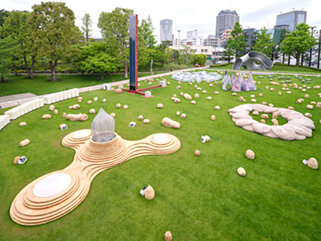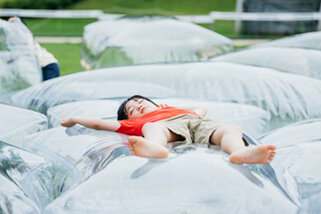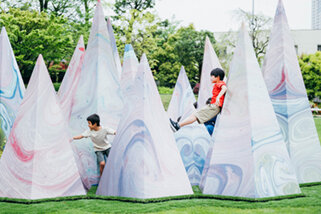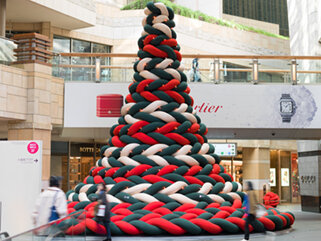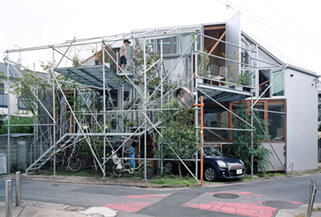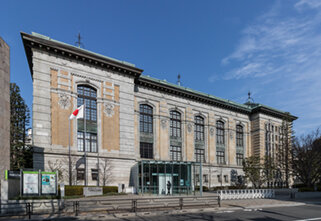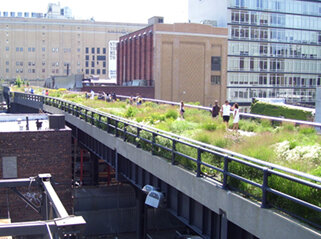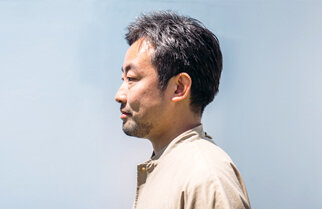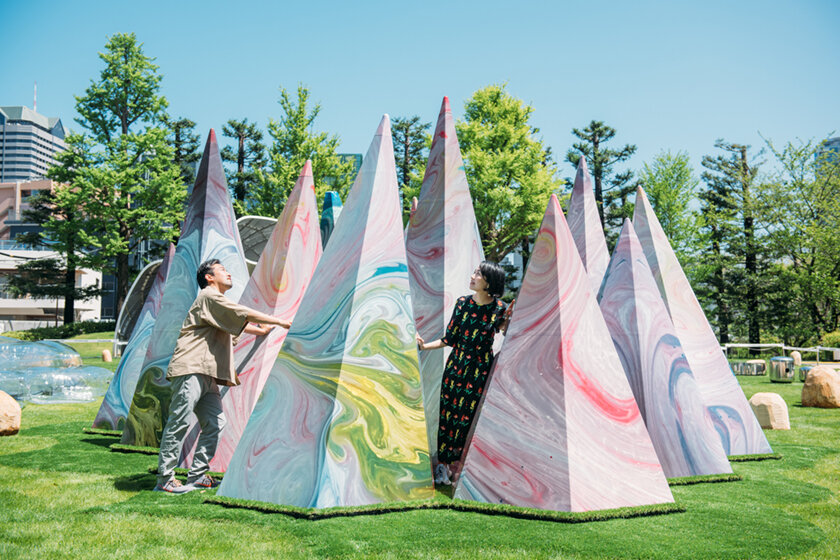

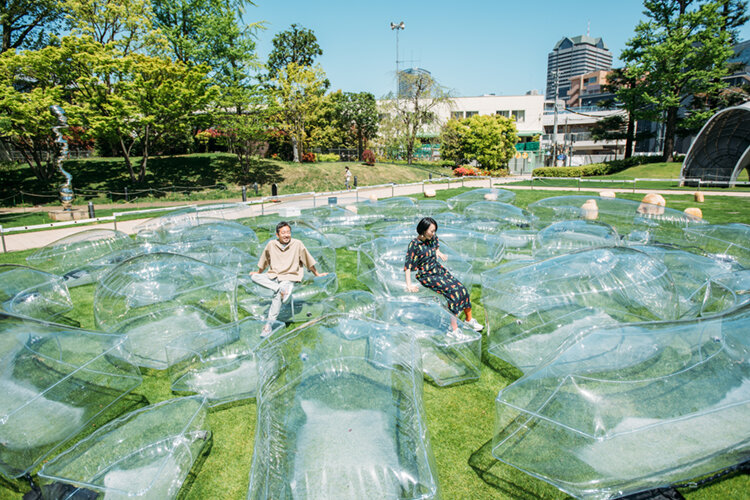
INTERVIEW
137
Suzuko Yamada × Yusuke OonoArchitect × Architect
Looking for “Roppongi-like” Features in Areas that Aren’t
Connecting the things that seem out of place (i.e. unique) scattered around the city (Yamada)
A rambling nature walk for examining urban weeds (Oono)
Suzuko Yamada and Yusuke Oono are both architects noted for their works and endeavors that go beyond the boundaries of architecture. Yamada studied landscape design at Keio University before learning under Sou Fujimoto and creates architecture that hands control over to nature. Oono worked at an architecture firm in Portugal before working for noiz and eventually went independent. His work is not limited to architecture and ranges from massive installations to palm-sized products. The two of them are now involved in designing playsets for the GOLDWIN PLAY EARTH PARK currently set up on the Tokyo Midtown Grass Square. We interviewed them on a wide range of topics such as the process involved in making the playsets, the usual starting points in their creative processes, and their philosophies as university instructors.
The existence of nothingness. Playsets that reflect Japanese philosophies
Yusuke OonoMy idea for a playset in PLAY EARTH PARK originated when Goldwin asked me to propose something for kids to play on themed around the five elements that make up this planet. The theme I was asked to focus on was "void."
GOLDWIN PLAY EARTH PARK
PLAY EARTH (i.e. "playing with the earth") is a project by Goldwin to create a new relationship with nature and the environment through the concept of "play," which is the origin of sports. For their PLAY EARTH PARK project set up on the Tokyo Midtown Grass Square, five architectural firms have designed playsets that incorporate the themes of "nature," "children," and "play." Each of the five firms worked with one of the five elements — earth, water, wind, void, or fire — as their motif. The event is on from Saturday, April 23 to Sunday, May 29, 2022.
Suzuko YamadaMy theme was "earth." All of us worked on our respective themes at the same time, so today at the opening was the first time I saw Oono-san's work properly. I had heard from him that they were "pretty much like pool floats," but now that I see them they're actually on a much bigger scale than I imagined. How did you interpret your theme "void"?
OonoI started by considering what "void" actually means. Through this thought process, I realized that Japanese has multiple words that express the concept of void, or the existence of nothingness. That's how I decided that the theme for the "void" playset would be "nothingness." Then I wondered if there was anything that was shapeless but could still touch air, and I ended up with the idea to make some inflated airbags of various shapes and scatter them around, which seemed fun.
YamadaI see. Those sizes are great in relation to kids.
OonoSeveral kids can lie on top of the bigger airbags, but when someone flops onto one side of the bag it makes the kid on the other side bounce up. I hope the kids will be able to use their whole bodies to experience how air can become a medium to convey both human presence and energy. In addition to creating a diverse range of shapes, I was also very particular about keeping the profile of the bags low to the ground. This was because the low profile naturally makes kids want to climb on, and allows them to lounge on them face-up and gaze up at the sky above. I also wanted the bags to look as if they would make sounds like swishing water (laughs), so I was very specific about the texture of the material. They are not filled all the way with air, so their shape is determined by the weight of the person lying on top. There are 37 different shapes of airbags in all, and they are all collages of the characteristic curves used in products of the Goldwin apparel line. So if you look at them from above, they actually kind of look like sections of Goldwin clothing.
《Ultra Light Orchestra》
A playset with the elemental motif "void," designed by Oono. Transparent airbags line the area, which children can lie on or play with by seesawing on top and keeping balance.
Earth is mobile. Just enjoy and play with the playsets.
YamadaThe theme I was faced with was "earth." When you live in the city, it's very rare to be conscious about "earth," you know? But of the few occasions that I do notice, I most feel the presence of "earth" during earthquakes. I think the experience of the 2011 Tohoku Earthquake was a particularly big influence. I had always thought of the earth as something unwavering that we are securely settled on, but my perception changed completely when I realized that it's actually mobile and we're merely settled on it for the time being. That's why a part of me wanted this project to inspire urbanites who have limited opportunities to notice earth and children who have never experienced earthquakes to think about the mobility of the ground we stand on. I was exchanging ideas with the president of Goldwin when he mentioned that earth is an overwhelming presence that makes people feel miniscule. From there, I decided that I wanted to first design something with significant presence where you could feel a sense of mobility once you stepped in among them, and my design for the "earth" playset took shape.
《marble mountain》
A playset with the elemental motif "earth," designed by Yamada. Children can climb or explore among the mountain-like peaks adorned with marble patterns. Somewhere within is a cave-like hole to explore.
OonoThey look like sculptures from the outside, but when you go among them they suddenly look like mountains.
YamadaYes. The marble patterns are printed on mirror-like reflective sheets, and their function is to show the reflections. If there is a strong reflection, the reflected images of the surrounding people and scenery move along with you. That all melds into one large scene, and I thought that people might instinctively get a feel for the dynamism of how mountains and earth rise and shift.
OonoI see. I tried to get children to play using their whole bodies with my playset, and your "earth" also seems like one that requires children to use their whole selves.
YamadaThat's an aspect of play I placed importance on. I think children are true to their inexplicable impulses of wanting to move. For example, you know how when kids find a narrow space between two walls, they just have to climb up between them like Spiderman (laughs). I love that kind of unexpected things kids do. So my aim was to create something that makes kids spontaneously want to engage with or climb up on.
OonoIt makes me want to play there, too (laughs). When I created a tree one time for the Christmas installation at Roppongi Hills called MY DEAR CHUNKY, kids engaged with it in all kinds of unexpected ways. They didn't just sit on it. They'd jump, get caught in between, or hug the oversized yarn. I really liked how relentless they were in taking new challenges. That's why I didn't want to limit the way kids could play with the "void" playset. "Something that becomes complete through human involvement" is an important theme for me when creating things.
MY DEAR CHUNKY
A Christmas tree set up in the West Walk area as part of the 2018 Roppongi Hills Christmas illumination event. The tree looked like it was knit from massive chunky yarn, with a design that invited visitors to touch or sit on it.
MY DEAR CHUNKY/ 2018/ ROPPONGI photographs by Gottingham
YamadaI know what you mean. I didn't design places to hold onto or anything for the same reason. It's okay if some kids just walk among them and others climb, depending on what they want.
OonoThat's what makes playsets so interesting. Personally, I had always been interested in playground equipment, and I have a collection from the past few years of intriguing ones I've been finding from all over the world on Instagram. I like to look at them and contemplate. For example, German ones are interesting in that the shapes and materials are all different, and hardly any parks have the same equipment. Sometimes at first glance, it's not clear how kids are supposed to play with some of them. Perhaps Germany has different safety regulations from Japan, but I get the impression that they have a much more diverse range of equipment. Some of them looked too dangerous to be allowed in Japan. I think the perception of accountability differs by country. I don't mean to judge which is better, but I just think it's interesting how expectations for playground equipment can differ depending on how the people in that region think about accountability.

Architecture is like fabrics made up of countless layers
YamadaPLAY EARTH PARK was about designing playsets, but I know your creative output is always pretty diverse.
OonoIt's true that I do a lot of projects outside of architecture. But that isn't actually what I care about. For every project, an important premise for me is to think about who to collaborate with to make things interesting.
YamadaFor PLAY EARTH PARK, that would be your collaboration with the playground equipment specialists at JAKUETS?
OonoThat's right. I wanted to see what would happen if I mixed architecture with playground equipment specialists. It's interesting thinking about how to convert the safety regulations for playground equipment in positive ways and how to "hack" the specialists' knowhow. To maintain their configuration, the airbags we used are held in place with swing chains, which were materials that JAKUETS had. I would never have come up with that idea on my own, and I love that using the material makes the whole thing feel like playground equipment completely. That process reminds me of the video game Mega Man. The titular character Mega Man can only shoot simple bullets with his basic equipment, but every time he defeats a boss he takes on that boss's power and his outfit colors change. In a similar way, I get excited wondering what kind of new skills I'll unlock by collaborating with which people. Yamada-san, you also design things other than houses, don't you?
YamadaI don't consciously intend to work outside of architecture, and I consider any project as part of my architectural work, whether it's something I come up with or I'm commissioned to do. The fundamental base of what I do is made up of the everyday things that happen with the members of my firm, and the interests and values we share through consuming the same films, news, and books. I then think about how I'm going to embed those interests and values into the medium and add them as an extra layer on the way the viewers see the world. Even the greatest ideology is subject to constant change, just like the earth's environment. Meanwhile, I like to keep contemplating things like "Maybe this is how it is," "Or maybe it's actually that instead," and I hope that what we do serves as a cultural activity that updates human values as a whole. But in architecture a whole bunch of ideologies concerning buildings are overlapped as layers, so there is no single definite ideology. That was the thought behind "daita2019," the building I designed as my private residence.
daita2019
A steel and wood structure combined with an assembly of stairs and other elements, where the outside (i.e. yard) and inside (i.e. living space) become one to create a home. The two areas are loosely interwoven with the aim of creating the feel of living in nature, drawing on "the animal instincts that humans inherently possess."
PHOTO:yurika kono
OonoI know what you mean. There's no one context for architecture. It's more like something woven. I'm sure you don't think of architecture as isolated points, and create planes and three-dimensional structures by combing lines made from connections between a variety of things. That's why your creations have diverse values and different people interpret them in different ways, enriching them. I'm also drawn to architecture that is a convoluted mix of different layers.
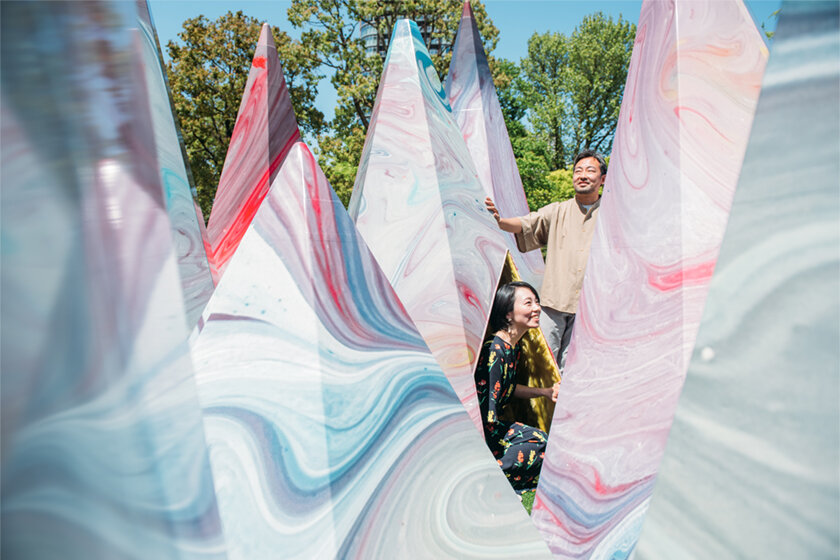
Wanting to teach students to "throw their values at others and having a response thrown right back at them."
OonoI currently teach a mandatory class for first-year architecture students at Tokyo University of the Arts with a very sober-sounding name: "Practice with Computer-Aided Design" (laughs). I understand you also teach at Kyoto University and Tokyo University of Science, Yamada-san. What kind of classes do you teach?
YamadaUntil very recently, I mostly taught classes on housing, but recently I've had more project-based classes where students work with a given theme. Last year, I chose "natural/unnatural" as the introductory theme for an architecture studio class. For example, we discuss whether skateboards are natural or unnatural, masks are natural or unnatural, and graves are natural or unnatural.
OonoThat sounds really interesting.
YamadaThrough the debate, the purpose is for students to discover new views on what is natural and unnatural to them. I taught this studio class with the idea that it could serve as a source of motivation when designing architecture. Introductory classes often tend to focus on getting students to learn how to draw lines, but in all honesty they'll get the hang of drafting and design once they get into it. More importantly, when they work at some architecture firm after graduation, and go independent in their thirties, I hope they'll have accumulated some sense of value and what they think is "natural" within themselves. Basically, I want them to experience "throwing their values at others and having a response thrown right back at them" on an everyday basis. We do that kind of thing as a routine exercise in my studio classes.
The importance of learning "how to create concepts" and experiencing the process
OonoYour classes are great in that they teach how to create concepts even if the students can't structure them at that time. I always want my classes to be the same. In terms of the technical aspects of using computer-aided design (CAD), you can just look on YouTube and find a lot of people who teach them much better than I do, as well as tips that can be accessed all over the world. That's why I only teach the bare minimum on how to actually use digital tools.
Instead, my goal is for students to experience, through a variety of projects, the process of taking the hazy ideas and forms they have in their heads and materializing them externally using CAD as a tool. A recent project I assigned was entitled "Impressionist Modeling." Using CAD involves a logical building process where you input quantitative values such as heights and lengths to create three-dimensional shapes. However, my project challenges students to model spaces using impressionism instead of realism, just like how impressionist painters expressed the impressions they felt through their works.
YamadaThat's interesting. What kind of things do you actually do?
OonoThe students go out to some place that intrigues them and start by describing the impression they get from the place with a poem or short text. Then they use the words as a reference to observe the elements of that space and reconstruct it. An interesting example was a student who chose to look at the building of the International Library of Children's Literature designed by Tadao Ando, located in Ueno, Tokyo. The student said, "there were blue areas and red areas." When you actually take a look through the building, the area facing outward has the blue sky coming in through aluminum and glass, making that entire space kind of blue. On the other hand, the bookshelf and common room areas are filled with the conventional, warm color of wood. The chairs designed by Ando-san are even made out of red wood. Noticing this, the student created a model that was a mix of red and blue. At our in-class critique we were able to discuss different perspectives for making observations instead of evaluating technique, so I think it turned out to be a pretty interesting project.
The International Library of Children's Literature
Japan's first library dedicated to children's literature. The original building was built in 1896 as the Imperial Library. It was renovated by Tadao Ando with the goal of preserving the original structure as well as the internal and external designs as much as possible. The library is comprised of the Brick Building, which retains its original Western Renaissance-style, and the Arch Building, which is notable for its full glass wall and beautiful curving design.
YamadaThat sounds like a very intriguing class. Expressing things as words is difficult without some amount of training. I think everyone has likes and dislikes, but people aren't aware of them a lot of the time. It's very important to be aware of "why you prefer brighter colors to black," or "why you like soft things but not hard things." I think that's basically what architecture is about. Once you can put things into words, when they ask you to design a library, you'll have the means to think properly about what kind of library it should be. I think being able to put things into words is more important than anything else.
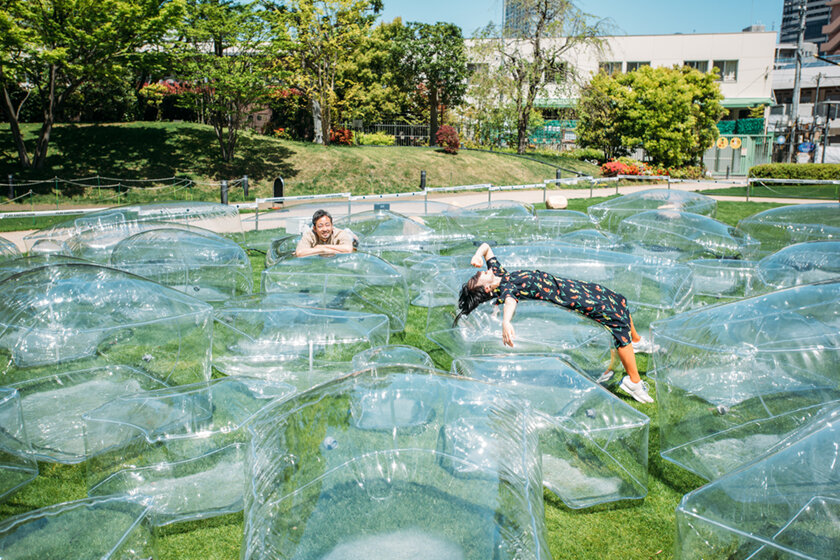
Finding "like-ness" in things that feel out of place.
OonoIt might be fun to do an event or project for general people in society to experience the kinds of things we teach at our universities. For example, we could do something like Yamada-san's class with the natural/unnatural theme and look for things that seem out of place in Roppongi. I just thought it would be fun to have everyone find places that don't seem "Roppongi-like."
YamadaI think there are definitely a lot of interesting things to be found in Roppongi if you take a proper look. The district that has Tokyo Midtown and the National Art Center, Tokyo has a different vibe compared to the area south from the Roppongi Crossing, don't you think? Perhaps because the south area is older, it feels more crowded and disordered. There are more people of other ethnicities there, too.
OonoThat's true. There are a lot of embassies there.
YamadaThere are a lot of restaurants from other cultures too, and the area's kind of ostentatious in a fun way. That's all surface-level stuff such as the signs and facades, but those are the things that create the atmosphere of a street, right? Roppongi is a city where individual buildings with big egos keep springing up all over, in a good way. The resulting cityscape of them all lined up together is very interesting. I really think that in a way, humans thrive built on rich individualities that each stand out in their own instead of in perfectly neat grids. On the other hand, Roppongi has also been heavily redeveloped, so I don't think there are many places that people can interact with on a personal level, compared to a city built on a "human scale." The spaces in between the redeveloped areas and the residential areas have a good scattering of things that feel out of place. I think connecting those dots and making some mischievous additions would bump the city up to make it even more interesting. I can't think of specific examples without actually going to the places, but I am interested in doing something to the walls or hand railings or fences on the border between Tokyo Midtown and Roppongi Hills. Maybe bending them into a bench, for example. It may not get rid of the boundary and might even accentuate it instead, but I would want it to be more than just a partition and become something with conscious humor.
OonoThat sounds great. In terms of things that feel out of place... In the last few years, I've been very interested in the ecology and shapes of plants. The science and design of plants is super interesting. It's partly due to influence from my "wild scientist" friend Kosuke Katano. One interesting thing I learned from him was about New York City's High Line by landscape designer Piet Oudolf, which is a very lovely place filled with all kinds of plants. He told me that the ecosystem of weeds growing under the elevated High Line is actually quite interesting to observe. Seeds and genetic information from the diverse range of plants on the High Line get carried by the wind, birds, and people, affecting the surrounding vegetation.
High Line
A public park in Manhattan that was made from renovating the railroad of the former West Side Line. The garden was designed by Piet Oudolf, with the aim to create a sustainable environment that is as close to nature as possible, using mostly plants native to New York.
Roppongi also has a lot of places that have undergone landscape design or redevelopment, so I feel like some fascinating things must be going on with the weeds in the area. It might be interesting to go on a walk and just ramble around to look for out-of-place weeds.
YamadaWhether it be weeds or parts of the town, it might be a good idea to look for things that are out of place.
OonoYes, like looking for a place that makes you go, "Is this really Roppongi"? Conversely, there might be people living in the area who say that place is what's truly "Roppongi-like." I feel like there would be a lot of discoveries on both sides.
Photo location: GOLDWIN PLAY EARTH PARK (April 23 to May 29, 2022)
Editor's Thoughts
I conducted this interview on a terrace with a full view of PLAY EARTH PARK. People who create things that make hearts tremble have concrete stories and powerful but gentle words.
If anything, listening to these two talk reconfirmed my opinion that those who don't possess any words that are a result of thorough deliberation probably do not have the means to create at all. Although they use architecture as the medium with which to materialize their words and thoughts, those messages are so universal and flexible that the medium could potentially be anything. It was a luxury to hear their delightful stories as the refreshing breeze blew through, told in pleasant voices that seemed to embody the two architects' solid and unwavering personalities. (text_akiko miyaura)
RANKING
ALL
CATEGORY




